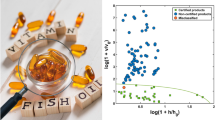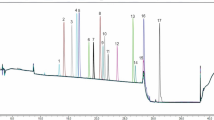Abstract
Ester and amide derivatives of hydroxycinnamic acids are found in black cohosh (Actaea racemosa) and other Actaea plants. These two compound groups were evaluated for authentication of black cohosh dietary supplements. The hydroxycinnamic acid esters (HCAE) were profiled by ultra-performance liquid chromatography-photodiode array detection (UPLC-PDA). The hydroxycinnamic acid amides (HCAA) were acquired simultaneously by mass spectrometry-multiple reaction monitoring (UPLC-MRM) mode. In contrast with the traditional HCAE method using 8 compounds, profiles of HCAA using only 4 feruloyl dopamine-O-hexosides was more convenient for peak by peak comparison. Partial least square discriminant analysis (PLS-DA) was applied to both HCAE and HCAA datasets. Authenticated plant samples of five Actaea species were randomly divided into training and test sets to build and validate the two PLS-DA models. Both models provided reasonable estimates for the classification of A. racemosa and other Actaea plant samples. However, HCAA model performs better in sensitivity, specificity, and accuracy. Assessment of supplement samples provided quite different results for the solid and liquid dietary supplement samples, indicating the dosage form could affect the composition of marker compounds.

Graphical abstract




Similar content being viewed by others
References
Predny ML, De Angelis P, Chamberlain JL, United S, Forest S, Southern Research S. Black cohosh (Actaea racemosa) : an annotated bibliography. Asheville: Southern Research Station; 2006.
Dietary Supplement Label Database. 2018. National Institutes of Health. http://www.dsld.nlm.nih.gov/dsld/index.jsp.
Blumenthal M, Rountree R. Botanical adulterants and safety: a clinical conversation with Mark Blumenthal and Robert Rountree, MD. Altern Complement Ther. 2015;21(3):116–20.
Foster S. Exploring the peripatetic maze of black cohosh adulteration: a review of the nomenclature, distribution, chemistry, market status, analytical methods and safety. HerbalGram. 2013;98:32–51.
Harnly J, Chen P, Sun J, Huang H, Colson KL, Yuk J, et al. Comparison of flow injection MS, NMR, and DNA sequencing: methods for identification and authentication of black cohosh (Actaea racemosa). Planta Med. 2016;82(3):250–62. https://doi.org/10.1055/s-0035-1558113.
Gafner S. Black cohosh adulteration laboratory guidance document. 2015
Applequist WL. Rhizome and root anatomy of potential contaminants of Actaea racemosa L. (black cohosh). Flora - Morphology, Distribution, Functional Ecology of Plants. 2003;198(5):358–65. https://doi.org/10.1078/0367-2530-00108.
Baker DA. DNA barcode identification of black cohosh herbal dietary supplements. J AOAC Int. 2012;95(4):1023–34. https://doi.org/10.5740/jaoacint.11-261.
Parveen I, Gafner S, Techen N, Murch SJ, Khan IA. DNA barcoding for the identification of botanicals in herbal medicine and dietary supplements: strengths and limitations. Planta Med. 2016;82(14):1225–35. https://doi.org/10.1055/s-0042-111208.
Gafner S, Sudberg S, Sudberg EM, Villinski JR, Gauthier R, Bergeron C. Chromatographic fingerprinting as a means of quality control: distinction between Actaea racemosa and four different Actaea species. Acta Hortic. 2006;720(Proceedings of the IVth International Conference on Quality and Safety Issues Related to Botanicals, 2005):83–94. https://doi.org/10.17660/ActaHortic.2006.720.8.
Avula B, Ali Z, Khan IA. Chemical fingerprinting of Actaea racemosa (black cohosh) and its comparison study with closely related Actaea species (A. pachypoda, A. podocarpa, A. rubra) by HPLC. Chromatographia. 2007;66(9/10):757–62. https://doi.org/10.1365/s10337-007-0384-6.
Jiang B, Ma C, Motley T, Kronenberg F, Kennelly EJ. Phytochemical fingerprinting to thwart black cohosh adulteration: a 15 Actaea species analysis. Phytochem Anal. 2011;22(4):339–51. https://doi.org/10.1002/pca.1285.
Ma C, Kavalier AR, Jiang B, Kennelly EJ. Metabolic profiling of Actaea species extracts using high performance liquid chromatography coupled with electrospray ionization time-of-flight mass spectrometry. J Chromatogr A. 2011;1218(11):1461–76. https://doi.org/10.1016/j.chroma.2011.01.033.
Nuntanakorn P, Jiang B, Yang H, Cervantes-Cervantes M, Kronenberg F, Kennelly EJ. Analysis of polyphenolic compounds and radical scavenging activity of four American Actaea species. Phytochem Anal. 2007;18(3):219–28. https://doi.org/10.1002/pca.975.
Wang H-K, Sakurai N, Shih CY, Lee K-H. LC/TIS-MS fingerprint profiling of Cimicifuga species and analysis of 23-epi-26-deoxyactein in Cimicifuga racemosa commercial products. J Agric Food Chem. 2005;53(5):1379–86. https://doi.org/10.1021/jf048300d.
Harnly J, Lu Y, Sun J, Chen P. Botanical supplements: detecting the transition from ingredient to product. J Food Compos Anal. 2017;64:85–92. https://doi.org/10.1016/j.jfca.2017.06.010.
He K, Zheng B, Kim CH, Rogers L, Zheng Q. Direct analysis and identification of triterpene glycosides by LC/MS in black cohosh, Cimicifuga racemosa, and in several commercially available black cohosh products. Planta Med. 2000;66(7):635–40. https://doi.org/10.1055/s-2000-8619.
Cicek SS, Aberham A, Ganzera M, Stuppner H. Quantitative analysis of cycloartane glycosides in black cohosh rhizomes and dietary supplements by RRLC-ELSD and RRLC-qTOF-MS. Anal Bioanal Chem. 2011;400(8):2597–605. https://doi.org/10.1007/s00216-010-4068-y.
Jiang B, Kronenberg F, Nuntanakorn P, Qiu M-H, Kennelly EJ. Evaluation of the botanical authenticity and phytochemical profile of black cohosh products by high-performance liquid chromatography with selected ion monitoring liquid chromatography-mass spectrometry. J Agric Food Chem. 2006;54(9):3242–53. https://doi.org/10.1021/jf0606149.
Geng P, Harnly JM, Sun J, Zhang M, Chen P. Feruloyl dopamine-O-hexosides are efficient marker compounds as orthogonal validation for authentication of black cohosh (Actaea racemosa)—an UHPLC-HRAM-MS chemometrics study. Anal Bioanal Chem. 2017;409(10):2591–600. https://doi.org/10.1007/s00216-017-0205-1.
Li C, Chen D, Xiao P, Hong S, Ma L. Chemical constituents of traditional Chinese drug “Sheng-ma” (Cimicifuga Dahurica). II. Chemical structure of Cimicifugamide. Acta Chim Sin. 1994;52(3):296–300.
Li C, Chen D, Xiao P. Studies on phenolic glycosides isolated from Cimicifuga dahurica. Acta Pharm Sin. 1994;29:199.
Yim S-H, Kim H-J, Jeong N-R, Park K-D, Lee Y-J, Cho S-D, et al. Structure-guided identification of novel phenolic and phenolic amide allosides from the rhizomes of Cimicifuga heracleifolia. Bull Kor Chem Soc. 2012;33(4):1253–8. https://doi.org/10.5012/bkcs.2012.33.4.1253.
Zhang F, Han L-F, Pan G-X, Peng S, Andre N. A new phenolic amide glycoside from Cimicifuga dahurica. Acta Pharm Sin. 2013;48(8):1281–5.
Reynaud D. DNA sequencing of SRM 3295, Actaea racemosa: AuthenTechnologies, LLC; 2014.
Almeida MR, Fidelis CHV, Barata LES, Poppi RJ. Classification of Amazonian rosewood essential oil by Raman spectroscopy and PLS-DA with reliability estimation. Talanta. 2013;117:305–11. https://doi.org/10.1016/j.talanta.2013.09.025.
Ortiz MC, Sarabia L, García-Rey R, de Castro MDL. Sensitivity and specificity of PLS-class modelling for five sensory characteristics of dry-cured ham using visible and near infrared spectroscopy. Anal Chim Acta. 2006;558(1):125–31. https://doi.org/10.1016/j.aca.2005.11.038.
Armstrong N, Hibbert DB. An introduction to Bayesian methods for analyzing chemistry data: part 1: an introduction to Bayesian theory and methods. Chemometrics Intell Lab Sys. 2009;97(2):194–210. https://doi.org/10.1016/j.chemolab.2009.04.001.
Acknowledgments
This research is supported by the Agricultural Research Service of the US Department of Agriculture and an Interagency Agreement with the Office of Dietary Supplements of the National Institutes of Health (Grant Y01 OD001298-01).
Author information
Authors and Affiliations
Corresponding author
Ethics declarations
Conflict of interest
The authors declare that they have no conflict of interest.
Additional information
Publisher’s note
Springer Nature remains neutral with regard to jurisdictional claims in published maps and institutional affiliations.
Rights and permissions
About this article
Cite this article
Geng, P., Chen, P., Sun, J. et al. Authentication of black cohosh (Actaea racemosa) dietary supplements based on chemometric evaluation of hydroxycinnamic acid esters and hydroxycinnamic acid amides. Anal Bioanal Chem 411, 7147–7156 (2019). https://doi.org/10.1007/s00216-019-02082-9
Received:
Revised:
Accepted:
Published:
Issue Date:
DOI: https://doi.org/10.1007/s00216-019-02082-9




